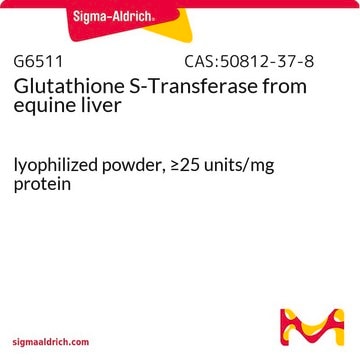おすすめの製品
由来生物
human
品質水準
リコンビナント
expressed in E. coli
アッセイ
>95% (SDS-PAGE)
形状
frozen liquid
比活性
183.9 units/mg protein
分子量
27.4 kDa
濃度
3.2 mg/mL
保管温度
−70°C
遺伝子情報
human ... GSTM5(2949)
詳細
using spectrophotometric determination of 1-chloro-2,4-dinitrobenzene (CDNB) conjugation with reduced glutathione (1 mM) in 100 mM NaPO4 (pH 6.5) at room temperature.
生物化学的/生理学的作用
Glutathione S-transferase mu 5 (GSTM5) is an enzyme that in humans is encoded by the GSTM5 gene. Glutathione S-transferases (GSTs) are a family of enzymes that play an important role in detoxification by catalyzing the conjugation of many hydrophobic and electrophilic compounds with reduced glutathione. Based on their biochemical, immunologic, and structural properties, cytosolic and membrane-bound forms of glutathione S-transferase are encoded by two distinct supergene families. At present, eight distinct classes of the soluble cytoplasmic mammalian glutathione S-transferases have been identified: alpha, kappa, mu, omega, pi, sigma, theta and zeta. The GSTs are thought to function in xenobiotic metabolism and play a role in susceptibility to cancer, and other diseases.
The GSTM5 gene encodes a glutathione S-transferase that belongs to the mu class. The mu class of enzymes functions in the detoxification of electrophilic compounds, including carcinogens, therapeutic drugs, environmental toxins and products of oxidative stress, by conjugation with glutathione. The genes encoding the mu class of enzymes are organized in a gene cluster on chromosome 1p13.3 and are known to be highly polymorphic. These genetic variations can change an individual′s susceptibility to carcinogens and toxins as well as affect the toxicity and efficacy of certain drugs. Diversification of these genes has occurred in regions encoding substrate-binding domains, as well as in tissue expression patterns, to accommodate an increasing number of foreign compounds.
保管および安定性
The enzyme should be used by the end-user customer within 1 year of receipt.
保管分類コード
10 - Combustible liquids
WGK
WGK 1
引火点(°F)
Not applicable
引火点(℃)
Not applicable
適用法令
試験研究用途を考慮した関連法令を主に挙げております。化学物質以外については、一部の情報のみ提供しています。 製品を安全かつ合法的に使用することは、使用者の義務です。最新情報により修正される場合があります。WEBの反映には時間を要することがあるため、適宜SDSをご参照ください。
Jan Code
GS59-100UG:
試験成績書(COA)
製品のロット番号・バッチ番号を入力して、試験成績書(COA) を検索できます。ロット番号・バッチ番号は、製品ラベルに「Lot」または「Batch」に続いて記載されています。
Ying Wang et al.
Journal of human genetics, 55(8), 490-494 (2010-05-21)
Coronary atherosclerosis is a complex and progressive condition that involves many biological pathways, including the oxidative stress and inflammatory response pathways. To investigate the association between common genetic variation within these two pathways and coronary atherosclerosis, we performed a comprehensive
Christian Delles et al.
Journal of hypertension, 26(7), 1343-1352 (2008-06-14)
Glutathione S-transferases are involved in defences against oxidative stress. We have recently demonstrated reduced expression of glutathione S-transferase mu type 1 (Gstm1) in a rat model of hypertension. Here, we examine the association between GSTM variants and hypertension in human.
Y V Patskovsky et al.
Biochemistry, 38(49), 16187-16194 (1999-12-10)
The hGSTM3 subunit, which is preferentially expressed in germ-line cells, has the greatest sequence divergence among the human mu class glutathione S-transferases. To determine a structural basis for the catalytic differences between hGSTM3-3 and other mu class enzymes, chimeric proteins
Variation in the GST mu locus and tobacco smoke exposure as determinants of childhood lung function.
Carrie V Breton et al.
American journal of respiratory and critical care medicine, 179(7), 601-607 (2009-01-20)
The glutathione S-transferases (GSTs) are important detoxification enzymes. To investigate effects of variants in GST mu genes on lung function and assess their interactions with tobacco smoke exposure. In this prospective study, 14,836 lung function measurements were collected from 2,108
Ann M Moyer et al.
Cancer epidemiology, biomarkers & prevention : a publication of the American Association for Cancer Research, cosponsored by the American Society of Preventive Oncology, 19(3), 811-821 (2010-03-05)
Lung cancer is commonly treated with platinum compounds. The "glutathione pathway" participates in the metabolism of platinum compounds. We set out to test the hypotheses that single nucleotide polymorphisms (SNPs) or copy number polymorphisms for genes within the glutathione pathway
ライフサイエンス、有機合成、材料科学、クロマトグラフィー、分析など、あらゆる分野の研究に経験のあるメンバーがおります。.
製品に関するお問い合わせはこちら(テクニカルサービス)







